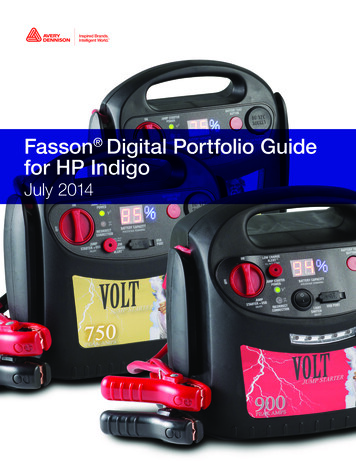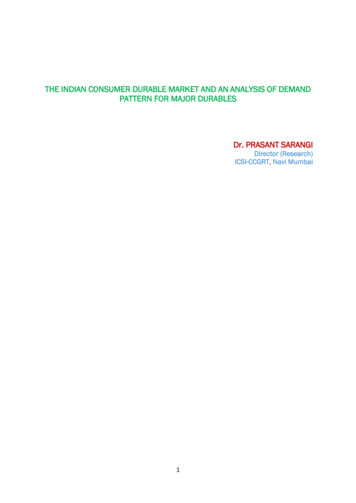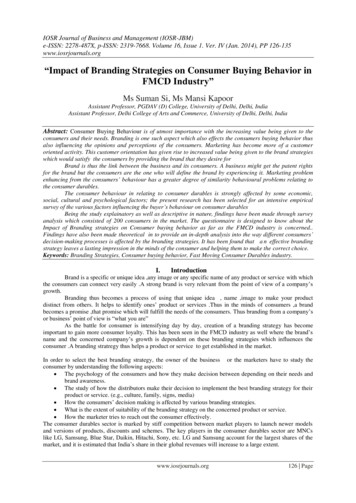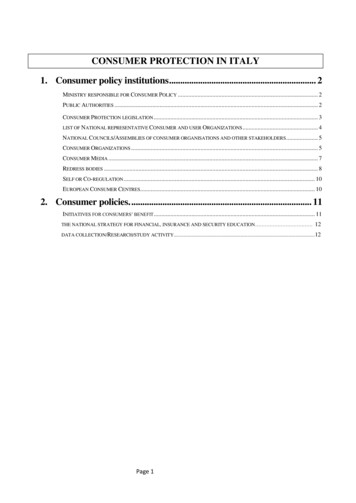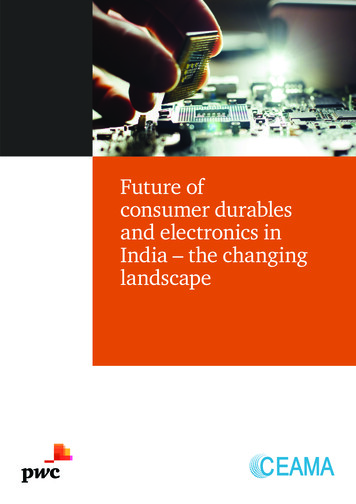
Transcription
Future ofconsumer durablesand electronics inIndia – the changinglandscapeCEAMA
ForewordIndia is seeing major changes in its policies, especially those related to the regulatoryand business environment. The government is making some long-due reformsleading to recognition in the ‘Ease of Doing Business’ rankings. The appliance andconsumer electronics (ACE) sector and the upcoming national policy for electronics(NPE) will further bring about major policy changes for the industry. The India growthstory is set for a major push given the low penetration levels of consumer durablessave for the television segment.While the cost of finance has gone up with various regulatory and energy efficiencyparameters, GST has led to benefits being passed on to consumers. There is a mixedenvironment with rising input costs and some operational efficiencies in the supplychain that have led to muted growth of the electronics and appliances industry. A fewsmaller segments such as refrigeration and washing machines are growing, whereasthe large television segment is seeing de-growth.To ensure a growth story across the board for the ACE sector, we need to havepolicies in place to create economies of scale and future free trade agreements(FTAs) (especially with consumption economies). These will be an impetus in the‘Make in India’ story and will reduce the cost of finance, thereby reducing the cost ofownership for the end consumers leading to a huge demand.CEAMA has joined hands with PwC again this year to look at the ‘Future of consumerdurables and electronics in India – the changing landscape’. I’d like to thank SomickGoswami and Rituparno Mukhopadhyay and their dedicated teams for articulatingtheir perspective.Manish SharmaPresident, CEAMA2 PwC
The macroeconomic indicators for the Indian economyhave been very positive over the last year. India is nowthe sixth largest economy and within striking distance ofbecoming the fifth largest. The icing on the cake has beenIndia leaping 23 notches in Ease of Doing Business 2018and breaking into the Top 100 for the first time.Having said that, what does this mean for the industryin terms of growth, its challenges, changing consumerbehaviour, complexity of the supply chain and adoption oftechnology in consumer durables while looking throughthe lens of Industry 4.0?The burgeoning middle class in urban areas andaspirational demand from rural India, coupled withgovernment reforms in the form of GST, are making theelectronic and appliances industry look positively towardsthe next phase of exponential growth. Along with risingincomes, the technological advancements to createconnected devices and the concept of smart homes arechanging the way consumers and the industry look atACE products. Consumers are becoming more and moretechnology savvy and manufacturers have to be ready tooffer the best of technological advancements to the usersand thereby increase investment into their R&D.With the explosive growth of e-commerce channelsand supply chain optimisation and consolidation ofthe traditional sales channels, the ACE sector is todayrevisiting the overall channel mix and spends on the same.There is an increased focus on increasing the servicedelivery mechanism and using it as a differentiator in theconsumer’s mind.However, there are challenges that the industry is facingdue to the fuzziness of manufacturing, compliance issuesand inefficient infrastructure. This is leading to higher costand lower value addition in the domestic market.Our report delves into the areas needed to boost growthin India’s ACE sector. PwC and CEAMA have againcome together this year to relook these aspects and putforth recommendations for the industry as well as thegovernment to move towards the next phase of sustainablegrowth. We have tried to bring in areas concerningmanufacturing and reforms on one side, growing consumerneeds on the other side, and internal governance andsupply chain needs on the ACE sector side.We take this opportunity to express our gratitude toindustry members who helped us contextualise andformulate our viewpoint and actionable recommendations.We would also like to thank Mr. Rohit Kumar Singh,CEAMA for his support, especially in facilitatinginteractions with CEAMA members who have providedvaluable insights that helped frame this report.Rituparno Mukhopadhyay and Somick GoswamiAdvisory Partners, PwC IndiaFuture of consumer durables and electronics in India – the changing landscape 3
Context andmethodologyWe followed a methodology of primary interviewsof the C-Suite among industry body members aswell as secondary research.Our report will further discuss the following: Overall consumer buying behaviour and macroindicators for ACE and other industry verticals(vis-à-vis FMCG and automotive); Technological changes in the ACE sectorleading to connected devices; The regulatory environment in manufacturingwith benefits and impediments for the ACEsector; Supply chain efficiency to reduce the overallcost of ownership; and Service as a differentiator for the industry.A survey was also conducted with CEAMAmembers to understand the trends related to theabove-mentioned aspects.4 PwC
AcknowledgementsMr. Manish SharmaPresident – CEAMA and President &CEO – Panasonic India and South AsiaMr. Sunil Vachani,Vice President – North,CEAMA and Chairman,Dixon TechnologiesMr. Eric Braganza,President,Haier Appliances India Pvt. Ltd.Mr. Kamal NandiVice President – West, CEAMA andBusiness Head and Executive Vice President,Godrej & BoyceMr. Gurmeet SinghChairman and Managing Director,Hitachi IndiaMr. Ravinder ZutshiPast President,CEAMA and Business Consultant, HavellsMr. Rohit Kumar SinghAssociate Secretary General, CEAMAFuture of consumer durables and electronics in India – the changing landscape 5
Table of contents1.2.3.4.5. 6.7.8.6 PwCMacroeconomic indicators and consumer behaviourwith respect to the ACE sector7Policy environment, challenges for the ACE sector andthe way forward11GST – has it made the industry more nimble?16Supply chain in the ACE sector and emerging trends20:LY]PJL HZ H KPɈLYLU[PH[VY PU [OL (*, ZLJ[VY 28Connected devices and emerging technologiesfor durables35Channel spends and challenges on ROI38Conclusion41
1Macroeconomicindicatorsand consumerbehaviourA look at the macroeconomicenvironment suggests that India’sconsumption story is poised foruninterrupted growth, which makes ita high-potential market for the retailand consumer goods sector.Future of consumer durables and electronics in India – the changing landscape 7
the UK in 2018 and secure the fifth position. This isparticularly impressive considering the overall strain theglobal economy (except for the possible exception ofthe US), including China, is continuing to experience. Ifthis upward trend continues, India’s GDP is expected totouch 9.6 trillion USD by 2020.2 The latest indicators fromIMF continue to place India on a relatively high growthtrajectory, as indicated below:After the apparent brakes demonetisation and theintroduction of the Goods and Services Tax (GST)applied on the growth rate in the country, recentreports issued by the International Monetary Fund(IMF)1 suggest that India has stepped up the gas on itsrate of development. Earlier in 2017, it overtook Franceto become the sixth largest economy in the world,measured in terms of GDP, and is expected to surpassCountry/regionExpected GDP growth rate China6.56.46.26.05.75.5United States2.92.71.81.71.41.3EU2.52.11.81.71.71.7Many macroeconomic fundamentals continue to supportthe case for India as the high-potential market for retail.3These include: India is the fastest growing major economy and secondlargest by population, accounting for 17% of the world’spopulation and 3% of the global consumption. It hasthe highest consumption growth amongst the top 10countries ranked by size of HFCE. Per capita income in India has nearly quadrupled sincethe start of the century, rising from 452.4 USD in 2000 to1577.6 USD in 2016. This has put more disposable cash inthe pockets of consumers who are not shy of spending it. The consumption growth in India can be attributed tothe democratic rise in affluence, which is not limited tojust the metros or a limited income bracketIn addition to the growing consumption, there are uniquedrivers that are causing the rapid growth of organisedretail formats.Digital influence: Digital penetration in India is growingrapidly: 13% of the population uses a smartphone, 91%of whom search for products to buy via their device and54% of them have completed a purchase. This level ofdigital maturity comes to a population with 37% Internetpenetration, growing at a CAGR of 31%, which is higherthan that in China and the US. This bodes well for thee-retail sector and omnichannel players.This shift in the overallmacroeconomic environmentof India will result in higheraffordability of consumer durablesand electronics products.Growth in young urban consumers and nuclearfamilies: Forty-seven percent of the population is underthe age of 25 years and India is slated to be the youngestcountry by 2020.4 Further, rising urbanisation (27% at thebeginning of the century to 32% in 2015) and increase inthe female participation in the workforce are also creatinga time-starved consumer group which is likely to paya premium for convenience. Nuclear families are alsoincreasing, with 70% households with a nuclear construct,up 13% over the past two decades – and nuclear familiesspend 20–30% higher than joint families.5Growth in aspirations: There is a growing trend amongIndian consumers to ‘uptrade’ to branded products fromthose sold ‘loose’, paying for service and convenience.This is driven by the shift in demographic structure,increased awareness about global trends, quest for betterproducts and focus on healthier a4aef3, 4, 5. PwC’s report ‘The promise of Indian retail’ (2017)8 PwC
The rapid rate of urbanisation and the growth of ayoung population that is enjoying rising incomes iscreating a large emerging middle class in India. Thissegment of the population is expected to grow by 21%over the next decade, from about 470 million peoplein 2010 to 570 million by 2021, constituting about 42%of the country’s total population.6 As digital accessbecomes more and more affordable, along withincreasing product awareness and a shift in lifestylepatterns, consumer spending on electronics andhome appliances could see strong growth in the nextfive years.Apart from the growing income levels, the other importantfactors are changing consumer behaviour and evolvingspending patterns. Indian consumers today are lookingto improve their homes and lifestyles through globalbrands and experiences. Fuelled by the falling prices ofconsumer electronics, these radical demographic shiftsare expected to further transform the consumer durablesand electronics market in India. The current subparpenetration levels, compared to the global average forconsumer durables and electronics products such as airconditioners, washing machines and refrigerators, alsohighlight the significant headroom for future growth.Household penetration of consumer durables and 31%8%23%13%4%IndiaChinaTraditionally, for many consumer electronics products,increasing market penetration has been a key driver ofsales growth. There exists a significant opportunity forcompanies to tap the huge potential, especially in the semiurban and rural markets of India. The government’s push forinfrastructure through the development of roads, rail andpower supply is helping to reduce the urban-rural divide.Global averageBenefiting from the fast-improving infrastructure,companies are looking to replicate the success of mobilephones in the white goods segment. However, today’sconsumers have high awareness and a strong value-formoney orientation. Multinationals worldwide are beingforced to work towards building products that can triggersimple behavioural shifts, grow demand and createbusiness value.Incumbent players are realising that it is no longerimportant to just achieve scale but equally importantto make consumption sustainable and more relevantto consumers by redesigning products and servicesto meet the needs of local markets. In addition,strengthening distribution and after-sales servicereach will be key for consumer durable and electronicsmanufacturers in driving innovation and productdevelopment at the local level.As spending patterns evolve and there is a shift in factorsdriving the purchase of electronic products, it will beimperative for companies to adopt the right strategy andapproach consumers by identifying specific areas ofopportunity within each category of products.6.PwC’s report ‘Championing change in the Indian ACE industry’ (November 2017)Future of consumer durables and electronics in India – the changing landscape 9
Product-specific demand drivers will lead to strong growth across allconsumer durables and electronics product segments.SmartphonesFeature phoneto smart phone;increased penetrationof Internet paymentsWashing machineShift from semiautomatic toautomatic; penetrationin tier 2, 3 townsTelevisionsShift to larger screen size;Internet penetration drivingdemand for smart TVs; increasein demand for flat panel TVsACsShift to split ACs;new energyefficient invertertechnologyRefrigeratorsPenetration intier 2, 3 townsForecasted growth in consumer durables and electronics product categories7Forecast2There are some headwinds that India as an economy and,more so, its ACE sector will have to deal with which aremore geopolitical in nature:CAGR2017-22 5025020172022As a result, the Indian consumer durables and electronicsindustry is expected to grow at about 9% over the next 4to 5 years. India’s overall retail opportunity is substantial,and coupled with the demographic dividend (youngpopulation, rising standards of living and upwardly mobilemiddle class) and rising Internet penetration, we are seeinga strong growth in the sector. The Indian government’sambitious Digital India project is expected to boost theadoption of e-commerce in remote corners of the country.Along similar lines, the government’s push towardsSkill India will also help in creating more technicians,who will help push the serviceability of white goodsand make service a revenue generator for the industry.Higher financial inclusion through mobile and increasingconnectivity in rural India will also lead to an increasein trade and efficient warehousing, thereby presentinga potentially large market for consumer durables andelectronics products.7.Exchange rate: With the dollar to rupee exchange rateincreasing from 63 INR to around 73–74 INR, the profitsof the ACE sector have been severely dented, making itimperative for the industry to raise prices or shift to localmanufacturing. With electronics being the second largestimport material (10.97%) next to only crude (27.07%), theindustry is clearly under strain due to the exchange rate.Trade war and oil prices: India’s public finances areincreasingly dependent on oil revenue and with oil at 3.3%of the GDP and increasing by the year, it will have a hugestrain on the economy. With trade wars escalating on topof the increasing oil prices, the headwinds are growingeven stronger.The following are the trends that we expect to see for thenext 5 years in the durable industry as a whole:1.Expansion into new segments: Many new players areentering the consumer durable sector as the futurelooks promising.2.Increased affordability and rising incomes:Advancement in technology and higher competitionare driving price reductions across various consumerdurable product segments.3.Focus on energy-efficient and environment-friendlyproducts: Companies also plan to increase the useof environment-friendly components and reducee-waste by promoting product recycling. India hasmade it mandatory for manufacturing companies tocontrol emissions from climate-damaging refrigerants(e.g. in the AC segment, many companies havestarted focusing on only invertor ACs).4.Powerful competitive and marketing strategy:Traditional sales models are slowly giving way toonline and social media related sales and helpingincrease the footprint of many of the mobile handsetproviders as well as new entrants to the market.PwC’s report ‘Championing change in the Indian ACE industry’ (November 2017), CEAMA, India Retail Report, Aranca research, India Brand Equity Foundation 201810 PwC
2Policyenvironment,challenges for theACE sector and theway forwardIndia is undergoing a major changein its economic environment andis growing fast. In the precedingchapter we showed the overall macroeconomic positives and challengesfor the industry. The current chapterdeals with the policy environment,challenges and the way forward for thesector to remain on the growth path.Future of consumer durables and electronics in India – the changing landscape 11
It is crucial to boost domestic electronics manufacturingthrough an enabling policy environment. Some ofthe challenges facing the appliance and consumerelectronics (ACE) industry include the following:a) CompetitivenessIndia has an advantage in terms of having a highlyskilled workforce that is available at a comparativelylower cost. This point combined with Englishbeing a widely spoken language lures companiesconsidering India as a base for setting up amanufacturing unit. These advantages, however,are often offset by the high manufacturing coststructure and lack of economies of scale. The costof finance, power and transportation together add acost disability of 7-8%8. Interest rates in India rangefrom 10 to 14% compared to approximately 5-6% incountries such as China, Vietnam, Japan and SouthKorea. Logistic challenges such as availability ofports and quality of infrastructure add to the cost ofmanufacturing in India.b) Free Trade Agreements (FTA)India has signed FTA with several countries suchas Singapore, Thailand and ASEAN. Under the FTA,each country is required to gradually reduce andeventually eliminate tariff rates on the other country’sgoods (including electronic goods) according to predecided timelines for implementation.9Energy Efficiency (BEE) under the Ministry of Power.This has been undertaken to limit the growingelectricity demand by introducing energy efficient,environment and cost saving appliances. While it iscrucial that consumer appliances in India continueto innovate to remain energy efficient, the industry isof the view that BEE is ‘pushing too fast, too ahead’in its aggressive push towards annually changingstringent standards.The BEE ratings are changing almost biennially,making it difficult for the industry to abide bythe norms and equip the appliances with newtechnologies. This has two implications for theindustry.1.The changing of standards results indowngrading of the existing 4 and 5-star ratedappliances, thus affecting the demand andreputation of the highly rated products.2.A phased approach in revising the standardswill allow the Industry to do a value add with theplanned R & D. Sudden changes increases thecost of the new product and renders the olderproducts obsolete much before the end of theirlifespan.As an example, the FTA signed by India are withproduction-driven economies resulting in finishedproducts from these countries being importedinto India at a cost lower than what it would havecost to manufacture the same products in India.This factor combined with the fact that in mostcases, components of the finished products aresubject to import duties at rates higher than theduties applicable on finished products, the FTA hascontributed to the decline of the manufacturing ofproducts in India.c) Compliance costsThe ACE sector has been witnessing an increasingcost burden due to the evolving nature ofcompliances prescribed by the Government inthe recent years. This cost burden is ultimatelypassed on to the consumer, making the productsunaffordable and having a detrimental impact ondemand. Following are a few of the complianceelements:a)BEE Star rating complianceA major segment of electronic durables such asair conditioners, refrigerators, geysers, colourtelevisions fall under the mandatory Standards andLabeling Programme introduced by the Bureau of8.9.CEAMA, October 2018ASEAN-India FTA Trade in Goods can%20(complete).pdf12 PwC
b)BIS testing and certificationAs a part of the Indian Government’s push towardsquality control, the ACE sector is required toensure testing and certification of its appliancesby the Bureau of Indian Standards (BIS). One ofthe challenges faced by the industry is the delayin the testing and certification of the products onaccount of a limited number of BIS approved labsin India. The increasing cost of compliance withenhanced fees adds to the cost of production forthe organized sector.”c)Environmental normsWhile plastic waste management rules ande-waste management rules and compliancewith its obligations is a progressive initiativetowards environment protection, lack of clarityin its implementation framework and uncertaintyaround the policy changes increase the overallcompliance costs. This leads to increasing the costof manufacturing in India resulting in an increase inthe price of the products, and that in turn negativelyimpacts consumer demand.d) Incentive schemes - modified specialincentive package schemeM-SIPS was introduced by the government to offsetdisability and attract investments in Electronicmanufacturing. It has been well appreciated bythe industry and helped in reducing domesticmanufacturers disabilities.Appliance and consumer electronics manufacturershave applied for and obtained the relevant approvalunder the modified special incentive packagescheme. The scheme provides for capital subsidythat is an important aspect of making manufacturingcost efficient in India. The industry has been facingdelays in disbursements of the capital subsidyincentives, resulting in the industry being unable torealise the benefits of these schemes.Enablers required for the sector’s growth1. Unlocking demandThere is an urgent need to unlock domestic and exportdemand by making the ACE market affordable andincrease the economies of scale. Also some consumerdurables are considered luxury products from a GSTperspective. With changing lifestyle patterns andconsumer aspirations, such products have now becomea necessity that warrant revisiting the tax structure andrates. Below are some recommendations to achieve inthe short run:GSTTreat the entire consumer electronics segment as asingle category under GST to ensure uniformity inGST rate.“To increaseeconomies of scale,the Government needsto create opportunitiesand aggregatedemand that will allowthe industry to investin manufacturing inIndia.”Subsidies and incentives1.Provide consumers with incentives in the formof subsidies to encourage them to shift to higherstar-rated energy efficient appliances2.Provide subsidies to locally manufacturedproducts to help them compete with fullyfinished goods imported at zero duty under thecurrent FTA agreementsA leading Indian ACEmanufacturerFuture of consumer durables and electronics in India – the changing landscape 13
2. Cost competitiveness for ‘Make in India’“To promote domesticmanufacturing andboost exports, FreeTrade Agreementsshould be signed withconsumption driveneconomies, ratherthan production drivencountries.”A leading home and kitchenappliance brand manufacturerWith the advent of industry 4.0, an increase in manufacturingproductivity may be expected once businesses invest intechnological infrastructure and processes. However, to reapthe benefits of the productivity gains, it is crucial that costsrelated to operations, logistics, supply chain and sourcing donot offset the benefits. Below are some recommendations:FTAs1.India should focus on signing FTAs with consumptiondriven economies to promote an export focus and‘Make in India’ for the world2.Consider excluding ACE products from the futureFTAs, especially Regional Comprehensive EconomicPartnership (RCEP)Lower cost of components1.Short term measures include reducing the import dutyon components2.Incentivise research and development to beundertaken in India to build domestic capability to makecomponents that are currently unavailable in IndiaAccess to skilled manpower14 PwC1.Various schemes under Pradhan Mantri KaushalVikas Yojna and SANKALP to help benefit the SkillIndia movement and get ACE sector to be an activeparticipant in these schemes2.Industry may want to work with Polytechnics to createcourses for technicians enabled for Digital India andSmart India
3. Ease of Doing Business“Any policy changeshould be assessed onhow it impacts domesticdemand.”While the regulatory authorities have been working oncreating a conducive business environment, there havebeen frequent policy and regulatory changes that haveled to an increase in compliance costs thereby leadingto a decrease in demand for the ACE sector products.Therefore, any policy change needs to be accompaniedwith industry consultations to assess how it affectsconsumer demand and to avoid burdening consumerswith increased prices.Here are a few recommendations:A leading domestic appliancemanufacturerAccess to creditTo correct structural cost disadvantages and reduce the risks of investment, reduce the cost of financeby 50%Environmental norms1.Relax collection target in E-Waste (Management)Rules, 2016, and increase this gradually over thenext 10 years2.The government needs to conduct consultationswith the industry to clarify and improveimplementation of EPR under the e-waste andplastic waste rulesEnergy efficiency standardsThe ACE industry has been contributingto the growth of the manufacturingsector by adding value and generatingemployment. The immediate needof the industry is to reduce cost ofoperations and compliances to helpunlock the domestic demand andestablish economies of scale. To builda conducive ecosystem for ‘Make inIndia’, it may be useful to establisha nodal body or a facilitation unit forthe ACE industry within a governmentdepartment to cater to the specificneeds of the sector and provide supportin a focussed manner.1.Implement BEE compliances in a phased manner2.Reduce the frequency of upward revisions in thestandards and bring in changes in consultationwith the industryQuality control1.Increase the number of BIS labs for the testing ofconsumer electronics2.Increase efficiency in the testing and certificationprocess of BIS labs to reduce the time to marketfor a productImplementation of schemes and incentivesFaster approvals along with timely and efficientdisbursal of funds to eligible entities is needed tostrengthen the implementation of existing schemes forthe sectorCompliancesReduce the number of forms and compliances to beundertaken by allowing online filingsFuture of consumer durables and electronics in India – the changing landscape 15
3GST - hasit made theindustry morenimble?It’s been more than one year sincethe introduction of the GST in India. Inview of the magnitude of its impact,P[ TH IL WYLTH[\YL [V WHZZ H ÄUHS verdict. However, its impact is enoughMVY YLÅLJ[PVU VU OH[ VYRLK HUK what did not. This is a good time toexplore new ways of doing business,[OH[ HYL TVYL LɉJPLU[ HUK SHYNLS driven by commercial imperatives.16 PwC
Publicised as the ‘one nation one tax’, GST replacedthe multi-tax structure in India and brought with it freeflow of credits, overall reduction in the prices of goodsand services as well as barrier-free movement of goodsacross India. The roll-out of GST has been smootherthan expected, with little impact on overall businessoperations. Specifically with regard to the benefits for thesupply chain segment of businesses, with the advent ofGST, it has been observed that the value proposition isvisible across all touchpoints, which include procurement,manufacturing and distribution. Some of the majorimprovements witnessed by the businesses supply chainnetwork during the year are discussed below:Tax structureImplementation of GST has led to the replacementof a plethora of Central-level taxes (i.e. excise duty,countervailing duty, Central sales tax and service tax)and state-level taxes (Value Added Tax, octroi and entrytax, local body tax, luxury tax, etc.). As a result, the ratearbitrage prevalent under the pre-GST period whichimpacted the consumer behaviour from state to state hasbecome uniform upon implementation of GST. This hasled to consistency in product pricing across all stateswhich has immensely benefitted the business supplychain network and eased out operational and pricingissues on a state-level basis.Further, the tax structure under GST has been dividedinto five slabs—that is, 0%, 5%, 12%, 18% and 28%(proposed for ‘luxury’ goods)—along with compensationcess on specific categories of goods. The slab rateof 28% was mooted as too high compared to otherdeveloping economies and was largely hailed as adeterrent to the impacted industries. During the initialstages, the 28% rate category comprised all majorconsumer electronics, namely ACs, refrigerators, TVsand washing machines.Further, the unified tax structure across all states inIndia has streamlined the supply chain. It has triggeredthe need for consolidation of state-wise warehouseswhich were previously being maintained by businessesin various states from where business was undertaken.Businesses are now free to structure their distributionand procurement
factors are changing consumer behaviour and evolving spending patterns. Indian consumers today are looking to improve their homes and lifestyles through global brands and experiences. Fuelled by the falling prices of consumer electronics, these radical demographic shifts are expected to further transform the consumer durables
